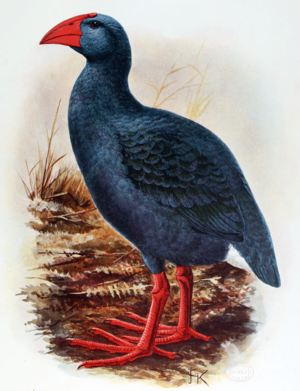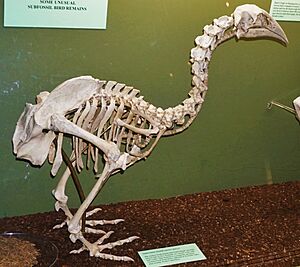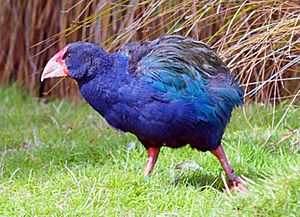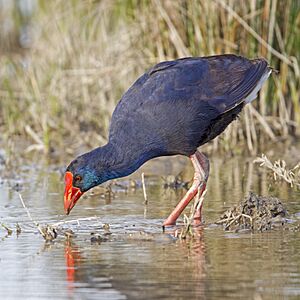Réunion swamphen facts for kids
Quick facts for kids Réunion swamphen |
|
|---|---|
 |
|
| Hypothetical reconstruction by John Gerrard Keulemans, 1907 | |
| Conservation status | |
| Scientific classification | |
| Genus: |
Porphyrio
|
| Species: |
caerulescens
|
 |
|
| Location of Réunion (encircled) | |
The Réunion swamphen (Porphyrio caerulescens), also known as the Réunion gallinule or oiseau bleu (French for "blue bird"), was a type of rail bird that lived only on the island of Réunion. We only know about this bird from stories written by visitors to the island in the 1600s and 1700s.
Scientists gave it a name in 1848, based on a description from 1674. Even though there's no physical proof, like bones, scientists today believe it was related to the swamphen birds. This bird was described as being completely blue with a red beak and red legs. It was said to be about the size of a Réunion ibis or a chicken, which means it could have been around 65–70 cm (26–28 in) long. It might have looked similar to the takahē bird.
Even though it was easy to hunt, it could run very fast and could fly, though it didn't like to. It probably ate plants and small bugs, like other swamphens. People said it built its nests in tall grasses and water ferns. This bird was only found on the Plaine des Cafres plateau, a high area on the island. While other swamphens live in wet, low-lying areas, this bird lived in the mountains. The last clear story about it is from 1730, but it might have lived until 1763. Sadly, too much hunting and the arrival of cats likely caused it to become extinct.
Contents
What is Taxonomy?
Taxonomy is how scientists classify and name living things. For the Réunion swamphen, it was tricky because there were no bones or specimens to study. Scientists had to rely on old descriptions.
Visitors to the island of Réunion in the 1600s and 1700s talked about blue birds. The first story came from a French traveler named Sieur Dubois in 1674. In 1848, a British scientist named Hugh Edwin Strickland thought Dubois's description sounded like a swamphen bird. However, he was unsure because the bird was described as very large.
Later that year, a Belgian scientist named Edmond de Sélys Longchamps gave the bird its first scientific name: Apterornis coerulescens. The name coerulescens is Latin for "bluish." He also grouped it with other birds from the Mascarene islands that were only known from old stories, like the Réunion ibis.
However, the name Apterornis had already been used for a different bird from New Zealand called the Aptornis (also known as adzebills). So, in 1857, a French biologist named Charles Lucien Bonaparte gave it a new name: Cyanornis erythrorhynchus. That same year, a German scientist, Hermann Schlegel, suggested it belonged to the Porphyrio genus, like the takahē from New Zealand. He said that since the takahē was also a large Porphyrio bird, the Réunion swamphen's size wasn't a problem.

Through the 1900s, most scientists thought the bird was a type of Porphyrio or Notornis (which is now considered the same as Porphyrio). Some even thought it was the same as living swamphens, but this didn't make sense because the Réunion bird lived in mountains, not swamps.
In 1974, people tried to find fossils on the Plaine des Cafres plateau, where the bird was said to live. They didn't find any caves that might hold old bones, so more study was needed. In 1977, an American scientist, Storrs L. Olson, agreed that the old stories matched a unique Porphyrio bird. He believed its remains might be found one day.
In 2008, scientists Anthony S. Cheke and Julian P. Hume said that the Réunion swamphen is still the most mysterious of the Mascarene birds from old stories because no physical evidence has been found. Hume wrote in 2019 that there's no doubt it was a type of Porphyrio because only birds in that group are completely blue among rails.
What Did It Look Like?

The Réunion swamphen was described as having feathers that were entirely blue. It also had a red beak and red legs. Scientists generally agree it was a large bird that spent most of its time on the ground. It likely had strong legs and wasn't a great flyer.
There was some confusion about its exact size. Dubois said it was as big as a Réunion ibis, while another account from 1704 by Jean Feuilley said it was the size of a domestic chicken. However, scientists later explained that a Réunion ibis was about 65–68 cm (26–27 in) long, and wild chickens could be 65–70 cm (26–28 in) long. So, there wasn't a real difference. This means the Réunion swamphen was probably about the same size as the takahē bird.
The first description of the Réunion swamphen, from Dubois in 1674, said:
As big as the solitaires [Réunion ibis]; their plumage is entirely blue, the beak and the feet red and made like those of hens; they do not fly, but run extremely quickly, so that a dog has difficulty catching them in a chase; they are very good [to eat].
The last clear story about the bird is from a priest named Father Brown around 1730:
Towards the east of the island there is a little plateau up a high mountain called the Plaine des Cafres where one finds a large blue bird whose colour is very striking. It resembles a wood-pigeon. It flies but rarely and always barely above the ground, but it walks with surprising speed. The inhabitants have never called it anything other than oiseau bleu; its flesh is quite good and keeps well.
When Father Brown compared it to a "wood pigeon," he might have meant the common wood pigeon, suggesting it was smaller than Dubois described. Or he might have meant the extinct Réunion blue pigeon.
Since we only have written stories, artists have tried to draw what the Réunion swamphen might have looked like. These drawings show it as a mix between the takahē and the Aptornis, which some thought were its closest relatives.
Behaviour and Ecology

We don't know much about how the Réunion swamphen lived. It was easy to catch and kill, which is different from other swamphens that fly away or hide from danger. However, it could run very fast. Some early researchers thought it couldn't fly at all, but Father Brown's story says it could, though it didn't like to.
Scientists think it probably ate plants and small bugs, just like other swamphens. Later in its existence, it seemed to live only in the mountains, especially on the Plaine des Cafres plateau. This area is about 1,600–1,800 m (5,200–5,900 ft) high in the middle of Réunion. The habitat there is open woodland with some marshy pools.
Dubois called the Réunion swamphen a "land-bird," even though most other swamphens live in wet, low-lying swamps. This is similar to the Réunion ibis, which lived in forests instead of wetlands, its usual habitat. Scientists think that the ancestors of these birds arrived on Réunion before swamps had fully formed. So, they adapted to the mountain habitats that were available.
Feuilley described some of the bird's habits in 1704:
The Oiseaux bleuff live in the plaines on top of the mountains, and especially on the Plaine des Cafres. They are the size of a large capon, blue in colour. Those that are old are worth nothing to eat because they are so tough, but when they are young they are excellent. Hunting them is not difficult because one kills them with sticks or with stones.
The only story about its nesting was from La Roque in 1708:
One sees there [the Plaines de Cafres] a great number of oiseaux bleus which nest among grasses and aquatic ferns.
Many other unique animals on Réunion became extinct after humans arrived and changed the island's environment. The Réunion swamphen lived alongside other birds that are now extinct, like the Réunion ibis and the Mascarene parrot.
Why Did It Become Extinct?
Many birds that live on islands and can't fly well are very easily affected by changes humans make. Because of this, more rail birds have become extinct than any other bird family. All six types of rail birds that lived only on the Mascarene islands are now extinct, all because of human activities.
The main reason the Réunion swamphen disappeared was too much hunting. People thought it was good to eat and it was easy to catch. Scientists also think that the introduction of cats to the island in the late 1600s played a part. Once these cats became wild, they reached the bird's mountain home and likely hunted them. Today, wild cats are still a big threat to native birds on Réunion. The bird's eggs and chicks would also have been in danger from rats, which accidentally arrived in 1676.
The last clear story about the Réunion swamphen is from 1730. However, an anonymous story from 1763 might be the very last mention of this bird. It describes the bird's home, Plaine des Cafres, and how birds were hunted there:
The plain des Caffres, is formed by the summits of mountains at a very considerable elevation above the sea: it is said to be twenty miles in extent, and is very flat, and without stones. The access to it is very difficult in certain places, though it may be ascended on horseback. The air is very pure, but as cold as winter's day in England. When the clouds pass over the surface of the plain, they have all the effect of a gentle rain. A brook runs through the middle of it, which is broad but shallow, has a sandy bottom, and freezes in the winter.... There are also some curious birds, which never descend to the sea-side, and who are so little accustomed to, or alarmed at, the sight of man, that they suffer themselves to be killed by the stroke of a walking stick.
If the Réunion swamphen survived until 1763, it lived much longer than many other extinct birds on Réunion. This was probably because its mountain home was so remote and hard to reach.
See also
- List of extinct animals of Réunion



